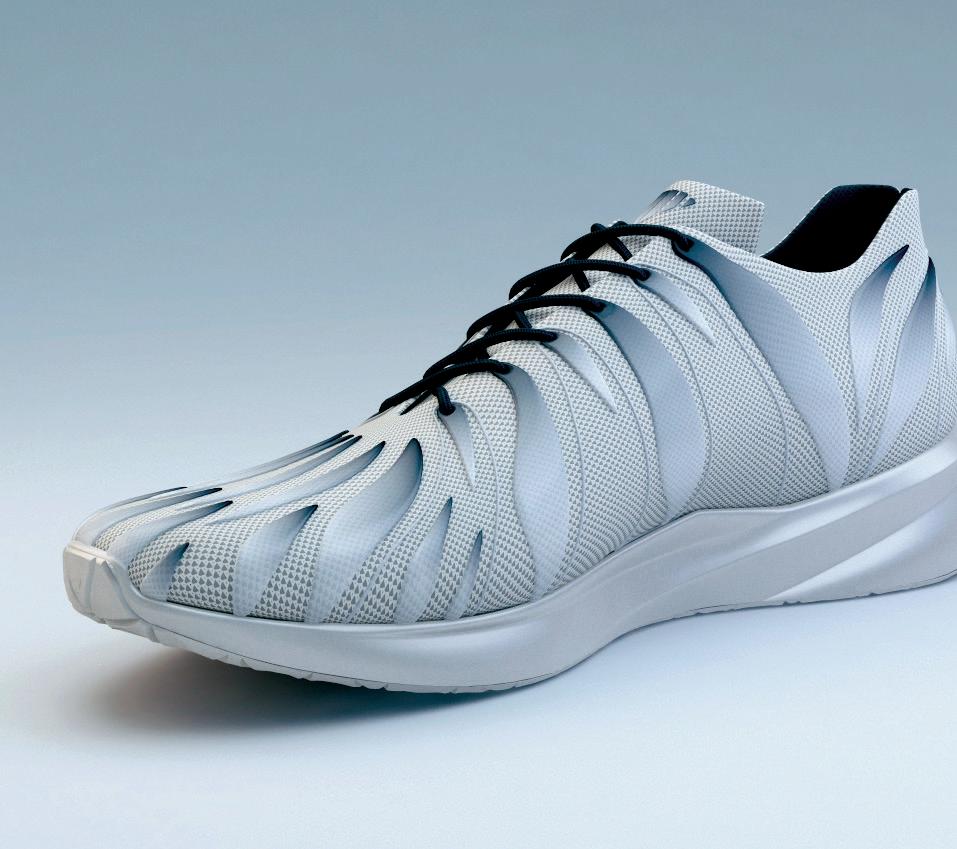sustainability
SOLUTIONS BY DESIGN
SPONSORED BY
WORDS: SAM DAVIES
E
verybody always has a tendency to exaggerate their industry in terms of importance, but frankly, I think the invention of additive manufacturing (AM) and the factoring in of algorithmic, AI-based design is at least as big as the invention of the microchip.”
Hyperganic CEO Lin Kayser is back talking about the potential he sees in burgeoning design and manufacturing technologies. We are a few months on from when he last spoke to TCT, where he referenced the ‘huge shift’ required to turn engineers onto AI-based design and where he outlined its importance. Each day, the climate crisis becomes more pertinent and so too does Kayser’s demand for design innovation. In the microchip, he sees a product type that has transformed the computing sector over the last few decades, and as it did, companies were forced to explore algorithmic design. Through Hyperganic, Kayser hopes to do the same for the rest of manufacturing. What motivated him to pursue this venture was Al Gore’s Inconvenient Truth, where Kayser's eyes were opened to the fact that reducing, reusing and recycling wasn’t going to be enough to tackle the climate crisis. Fifteen years on, Kayser has launched a software solution that he believes will significantly change the way products are made. And yet, he’s still regularly pursuing the insights from climate activists. More recently, he watched Christiana Figueres – renowned for her invovlement in the Paris Agreement – talk at the 2018 DLD Conference. It was further reinforcement that technologists will be key in addressing climate change. “When you talk to young people, a lot are saying, ‘Everything is going down the drain, my future is going to be less enjoyable than your past.’ And I don’t think that’s true,” he tells TCT. “I think we have the capabilities, and additive plays a huge role in that, to create something that is quite positive. I saw the invention of the smartphone. If
“The solution to climate change lies in industrial innovation.” you go back 10, 20, 30 years, there’s no resemblance to what it looked like before. It’s incredible how much has evolved. If we can move general manufacturing, design and engineering of objects to that paradigm, all bets are off how the next 1020 years are going to look like and that’s exactly what we need.”
AM has long touted its design capabilities to enable more sustainable products. But some have perhaps exaggerated that potential, or failed to mention how much energy is used and material wasted throughout the entire workflow. While efforts are now being made to ensure AM is as sustainable as it can be, Kayser suggests more will need to be done. “It’s not about lightweighting or making the supply chain shorter – this is a great start but it’s not going to be the significant part,” Kayser suggests. “The design innovation part is what is going to help us create objects and machines that can help us solve these crises. If you create completely new products, new breakthroughs in engineering, that’s how you get to [carbon] zero.” AI-based design – often in conjunction with additive manufacturing – is how Kayser thinks that can be achieved. Using algorithms, he believes a new level of design complexity can be reached; design cycles can be significantly sped up; and knowledge can be more easily shared across industries. Kayser’s vision for the future of design and manufacturing is one that leans heavily on innovation and on manufacturers being prepared to change the way they do things. But, as he expects to hear at the upcoming UN Climate Conference in Glasgow, it’s imperative that they do. “I think [design innovation] is probably the decisive element,” Kayser finishes. “I can only quote Christiana Figueres. She said that the fourth industrial revolution is the one thing that can solve this, nothing else. I don’t think we should forget about all the other things, lifestyle changes etc, there’s lot of things that can help us become more sustainable. But the solution lies in industrial innovation. I think it is probably the most critical component.”
VOL 7 ISSUE 5 / www.tctmagazine.com / 025











